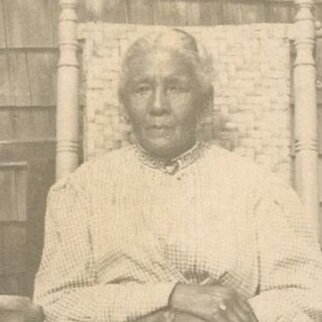Emma Jennings, Deer Island, Maine, Nathaniel Banks Collection, Waltham Public Library
EMMA Jennings (1833-1912)
Emma Jennings was born into slavery in Washington, DC. A few years after her release from bondage by a Mrs. Mary Bond of Virginia, she found employment for a pair of anti-slavery, former cotton mill workers from Waltham, Massachusetts named Banks. Mary Banks and her husband Congressman Nathaniel Banks were living with their young children in the nation’s capitol while he was Speaker of the House. Like so many who opposed slavery, the Banks family was especially cognizant of injustices affecting another broad sector of the population: women.
Because no personal papers of Emma Jennings have come to light, we do not know for certain her thoughts on voting rights. But we do know that she lived in a household that encouraged women’s employment, women’s engagement in politics and the women’s vote. At the very least, Jennings was a caregiver, providing essential work that would help make possible the Banks’ suffrage activities in the last decades of the 19th century.
Jennings joined the Banks household in about 1857, the year their youngest child Maude Banks was born. She helped bring up the children and support the family wherever they landed: in the District of Columbia, in Europe (where Emma must have learned to speak fluent French), on tour throughout New England, and in their primary home on Main Street in Waltham. She served the family for 60 years and is buried with them at Grove Hill Cemetery in Waltham.
Her employer Nathaniel Banks once said, “If the chief object of the people of this country be to maintain, perpetuate and propagate chattel property in man…this Union can not stand, and it ought not to stand.” (Harrington, 639). Later, as a Civil War general, he became a leader in defending that Union. He led the first all-black units of the war, and then the Reconstruction effort in Louisiana, where he called for education and partial suffrage for African-Americans. When asked about his feelings on race, he replied, “I accept the doctrine of the Declaration of Independence, that all men are created equal.” (Harrington, 642-643)
After the war, the entire Banks household was reunited in Waltham. General Banks entered once again into politics and was one of the few senators friendly to women’s suffrage as early as 1874. When Massachusetts enacted a law permitting women to vote in school elections—which was seen as consistent with their roles as nurturers of children—“Mrs. General Banks and her daughter led the list of registered women.” (Berenson, 74; Women’s Journal, July 19, 1879)
In 1884, both mother and daughter—Mary (age 63) and Maude (age 27)—were members of the Waltham Women’s Suffrage Club, made up of “old time suffragists, good true friends to the cause who yearly send in their petitions.” (Women’s Journal, Oct 18, 1884)
Raised since birth by Emma Jennings, Maude Banks would choose an unconventional lifestyle, making her claim to fame as an actress who portrayed powerful women such as Joan of Arc in the 1880s.
Joan of Arc, tortured and executed for her beliefs, represented a militant activism and determination that must have resonated not only with Maude but also her travelling companions: her mother and Emma Jennings. Such heroic female characters must have given them strength to deal with the harsh realities of being independent women in the 1880s. “We carry our own bags; we take the poorest rooms or fight our own fights at the hotels; we go to the theatre alone, and we try to keep on the good side of some man who will walk home with us.… We go to bed cold and hungry, and we are rapped up at four or five or six in the morning to start for the next town.” (Banks, 8)
Maude Banks as Joan of Arc https://broadway.cas.sc.edu/content/maude-banks
Not surprisingly, Joan of Arc would be adopted by later suffragists on both sides of the Atlantic who regularly portrayed this iconic medieval heroine in their pageants in the 1910s.
John Henry Adams, “Women to the Rescue!” The Crisis (May 1916): 43.
Shortly after Emma’s death in 1912, a black political cartoonist for the NAACP’s The Crisis magazine reinterpreted the archetypal female warrior figure as a modern black woman suffragist and mother in “Women to the Rescue.”
African-American suffragists like Ida Wells Barnett, Mary Terrell and Josephine St. Pierre Ruffin recognized that, with the vote, they could defeat segregation, Jim Crow laws, lynching and countless injustices that plagued African Americans in all corners of the US.
Waltham residence: 935 Main St. (ca. 1857-1912)
Banner image: Emma Jennings and Mary Palmer Banks, Nathaniel Banks Collection, Waltham Public Library.
Banks, Maude. “The Girl Who Sits in Front,” Ladies Home Journal, Feb, 1892, p. 8
“Banks Family Servant Dies: Miss Emma Jennings Passes Away Aged 78 Years, Oldest Colored Resident of City Born in Slavery,” Daily Free Press-Tribune, Waltham, March 21, 1912.
Broadway Photographs website. https://broadway.cas.sc.edu/content/maude-banks
Dockray-Miller, Mary, “Why Did the Suffragists Wear Medieval Costumes?” March 4, 2020. https://daily.jstor.org/why-did-the-suffragists-wear-medieval-costumes/
“Dramatical and Musical,” Boston Journal, Nov 13, 1886.
“A Faithful Servant: Had been with Gen. Banks’ Family over 40 years,” unidentified clipping, Banks Collection, Waltham Public Library, ca. 1901.
Harrington, Fred Harvey, “Nathaniel Prentiss Banks: A Study in Anti-Slavery Politics,” The New England Quarterly, vol. 9, no. 4 (Dec 1936), p. 626-654
Kirschke, Amy Helene, “DuBois and The Crisis Magazine: Imaging Women and Family,” Notes in the History of Art, Summer 2005, vol 24, no. 4 Special Issue on African-American Art (Summer 2005), pp. 35-45.
“Now with Her Husband: Widow of Late Gen. N.P. Banks Passes Peacefully Away,” Daily Free Press-Tribune, Waltham, Feb 1, 1901
“Served Family 50 Years: Miss Emma Jennings, Servant in the Home of Late Gen. Banks, Dies in Waltham—Born in Slavery,” The Boston Globe, March 21, 1912
The Theatre Magazine, April 5, 1890, vol 6, no 20, p 361
Woman’s Journal, May 23, 1874; July 19, 1879; Oct 18, 1884; Sept 8, 1894; Dec 11, 1897
“Women To The Rescue,” The Crisis, May 1916
Stonehurst Curator Ann Clifford wrote this biographical sketch in conjunction with “Anxious to Vote: Students, Workers and the Fight for Women’s Suffrage,” a curriculum and public education project developed in partnership by Stonehurst the Robert Treat Paine Estate and Waltham Public Schools in commemoration of the national suffrage centennial in 2020. STONEHURST is a National Historic Landmark owned by the City of Waltham. The once-private estate of generous social justice advocates whose ancestors helped establish the democratic foundations of this country is now appropriately owned by the people.
The Friends of Stonehurst received support for this program through “The Vote: A Statewide Conversation about Voting Rights,” a special initiative of Mass Humanities that includes organizations around the state.
This program is funded in part by Mass Humanities, which receives support from the Massachusetts Cultural Council and is an affiliate of the National Endowment for the Humanities.







